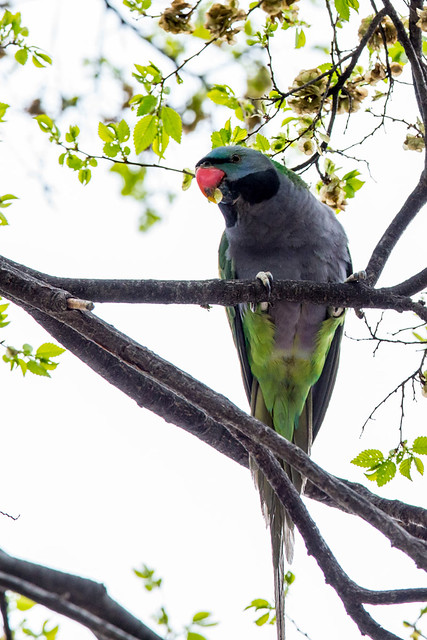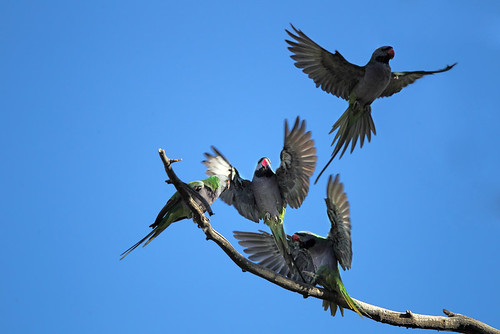 4 Male Lord Derby's parakeets bickering at the Norbulingka palace garden in Lhasa. Rarest Psittacula species of mainland Asia flourishes in Lhasa.
4 Male Lord Derby's parakeets bickering at the Norbulingka palace garden in Lhasa. Rarest Psittacula species of mainland Asia flourishes in Lhasa.
City Parrots has long advocated the use of cities in native ranges of parrots for their conservation. Psittacula parakeets seem particularly suitable for this type of conservation. 4 Species of the genus have established a presence in cities:
- Red-breasted Parakeet (Psittacula alexandri)
- Long-tailed Parakeet (P. Longicauda)
- Alexandrine Parakeet (P. eupatria)
- Rose-ringed Parakeet (P. krameri)
Today we can report a 5th species: Lord Derby's parakeet (Psittacula derbiana).
 Pine seeds are the staple diet of Lord Derby's parakeets. Image by zqr001We long suspected Lhasa to be suitable for Derbyan parakeets which are known in China as 大紫胸鹦鹉. It has come under considerable pressure over the last decades from the illegal pet trade in China. The species status was therefor updated from Least Concern to Near Threatened on the IUCN Red List of Threatened Species.
Pine seeds are the staple diet of Lord Derby's parakeets. Image by zqr001We long suspected Lhasa to be suitable for Derbyan parakeets which are known in China as 大紫胸鹦鹉. It has come under considerable pressure over the last decades from the illegal pet trade in China. The species status was therefor updated from Least Concern to Near Threatened on the IUCN Red List of Threatened Species.
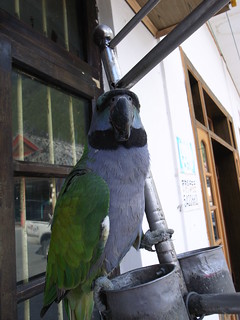 Captive Derbyan parakeet in the streets of Lhasa. Image by Chen ZhaoUrban parrots enjoy some reprieve from poaching as chopping down trees in urban parks to get to the baby parrots inside is usually frowned upon by the public and authorities. Conservation in an urban habitat would therefor be well suited for this parrot which suffers from poaching and the destruction of their nesting trees in that process. The species is traded far and wide in the region. Many a tourist returns home with pictures of Derbyan parakeets at Lhasa markets.
Captive Derbyan parakeet in the streets of Lhasa. Image by Chen ZhaoUrban parrots enjoy some reprieve from poaching as chopping down trees in urban parks to get to the baby parrots inside is usually frowned upon by the public and authorities. Conservation in an urban habitat would therefor be well suited for this parrot which suffers from poaching and the destruction of their nesting trees in that process. The species is traded far and wide in the region. Many a tourist returns home with pictures of Derbyan parakeets at Lhasa markets.
Parrots in trade do, on occasion, escape. Pictures of apparently free-flying Derbydan parakeets with broken leg chains are found on the Internet. Most urban parrot populations originate from such escaped pets.
We have personally seen a Derbydan parakeet doing well in a free-ranging parrot flock in a small town in Cumbria, UK and one escape has survived in the Netherlands town of Deventer for several years. So we knew it was a likely candidate for life in an urban habitat. Some birding tour operators indeed list the species for Lhasa. But we could not find any pictures confirming their presence. Other introduced parrots like the ubiquitous Ring-necked parakeet might confuse matters even further.
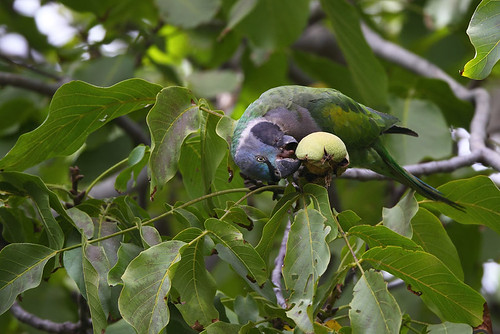 Lord Derby's parakeet (female) fouraging on a walnut at Norbulingka
Lord Derby's parakeet (female) fouraging on a walnut at Norbulingka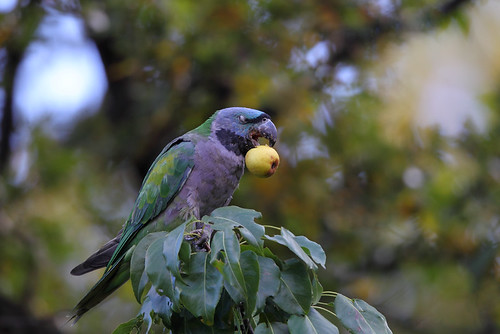 Enjoing an appleToday however I decided to search the internet using the Chinese characters for the Lord Derby's parakeet. With exiting results! Several people (see references below) share pictures of this species at the Norbulingka palace garden (羅布林卡). There are up to 4 males in one picture, several females and some birds not jet in full adult plumage, indicating successful reproduction. One photographer mentions it is a big flock. Some of the female birds show worn down tail feathers which is also a sing of recent breeding activities.
Enjoing an appleToday however I decided to search the internet using the Chinese characters for the Lord Derby's parakeet. With exiting results! Several people (see references below) share pictures of this species at the Norbulingka palace garden (羅布林卡). There are up to 4 males in one picture, several females and some birds not jet in full adult plumage, indicating successful reproduction. One photographer mentions it is a big flock. Some of the female birds show worn down tail feathers which is also a sing of recent breeding activities.
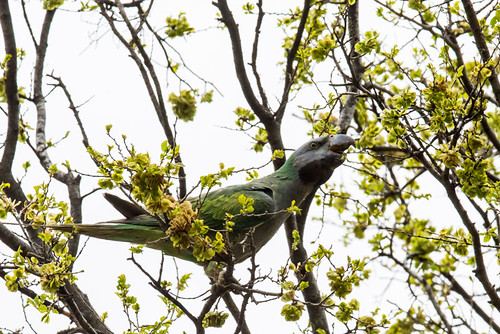 Elm seeds seem to be a favourite with Derbyan parakeets in LhasaThe birds are depicting feeding on Elm seeds, Pine seeds, Walnuts, Thuja fruits and something that looks suspiciously similar to an apple. We can’t rule out that these birds only pas trough Lhasa seasonally like Plum-headed Parakeets (Psittacula cyanocephala) seem to do in Delhi. The population in Tibet however is said to be mainly resident in contrast to the populations in India. The presence of these birds in the hart of this city is certainly encouraging.
Elm seeds seem to be a favourite with Derbyan parakeets in LhasaThe birds are depicting feeding on Elm seeds, Pine seeds, Walnuts, Thuja fruits and something that looks suspiciously similar to an apple. We can’t rule out that these birds only pas trough Lhasa seasonally like Plum-headed Parakeets (Psittacula cyanocephala) seem to do in Delhi. The population in Tibet however is said to be mainly resident in contrast to the populations in India. The presence of these birds in the hart of this city is certainly encouraging.
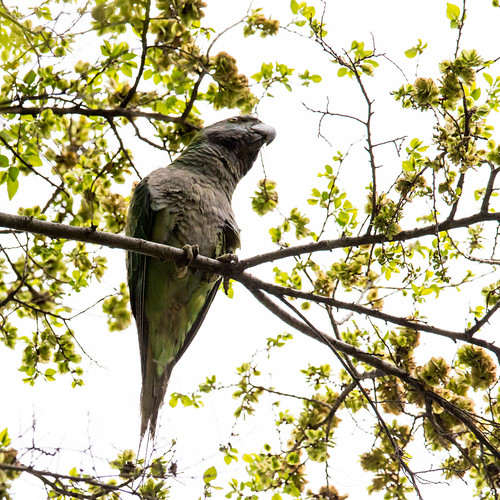 The damage to this birds tailfeathers is an indication of recent breeding activities.
The damage to this birds tailfeathers is an indication of recent breeding activities. 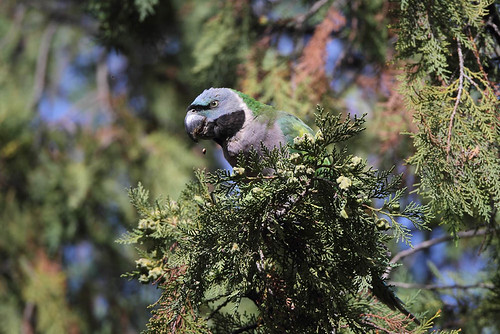 Thuja fruit is also on the menu. We expect Lord Derby's parakeets to show up in other cities in China. Larger cities within its natural range are Degen, Lijiang, Dali and Lincang. The same mechanisms of trade and escape apply there. As yet we have not found any confirmation of the species presence in any of these cities.
Thuja fruit is also on the menu. We expect Lord Derby's parakeets to show up in other cities in China. Larger cities within its natural range are Degen, Lijiang, Dali and Lincang. The same mechanisms of trade and escape apply there. As yet we have not found any confirmation of the species presence in any of these cities.
Please contact us whit more pictures and observations of these birds in the urban habitats of Tibet and China. Especially pictures that confirm the birds breeding in Lhasa or other cities.
